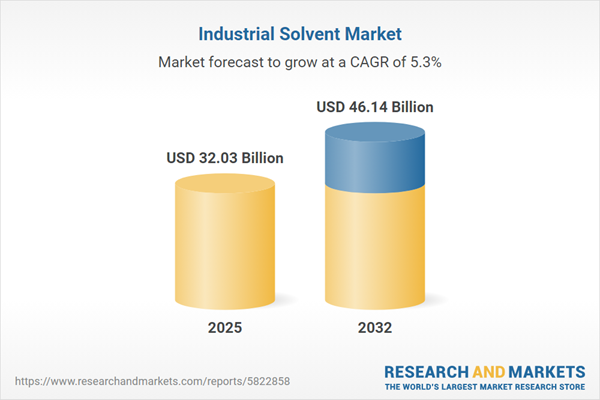Speak directly to the analyst to clarify any post sales queries you may have.
The industrial solvent market is undergoing significant transformation, driven by evolving regulations, new technologies, and heightened sustainability requirements. Senior decision-makers must adopt agile, data-driven approaches to secure operational resilience, ensure efficient procurement, and maintain a future-oriented competitive edge.
Market Snapshot: Industrial Solvent Market Growth and Outlook
The industrial solvent market is expanding steadily, anchored by continuous demand from key verticals such as chemicals, construction, electronics, personal care, and pharmaceuticals. Regulatory tightening and a pivot towards safer, more environmentally conscious solvent solutions are reshaping industry strategies. Adoption of digital manufacturing methods and modernized procurement processes is driving stability and improving reliability across global supply chains. As industry standards progress, organizations are leveraging new technologies to maintain compliance and respond to changing market needs, creating opportunities and addressing fresh challenges along the value chain.
Scope & Segmentation of the Industrial Solvent Market
- Solvent Types: Industrial buyers select from alcohols, chlorinated solvents, esters, glycol ethers, hydrocarbons (both aliphatic and aromatic, volatile and non-volatile), and ketones in response to specific application and compliance demands.
- Functional Roles: Solvents contribute to cleaning, dilution, extraction, and serving as reaction media, each supporting enhanced productivity throughout manufacturing processes.
- Source Selection: Procurement strategies weigh both chemical-based and bio-based options, balancing regulatory mandates and sustainability objectives for optimal sourcing.
- Forms Offered: Liquids and gases are available, allowing operations and engineering teams to tailor process control, precision, and flexibility to unique workflow requirements.
- Volatility Options: Both volatile and non-volatile solutions help organizations address performance, safety, and risk management across diverse manufacturing contexts.
- Distribution Channels: Sourcing occurs through a mix of traditional supplier relationships and digital procurement platforms, broadening supply chain resilience and regional responsiveness.
- End-Use Industries: Buyers operate across adhesives, sealants, paints, coatings, inks, construction, electronics, agrochemicals, personal care, and pharmaceuticals, adapting solvent innovation for sector-specific needs.
- Geographic Reach: Market participants maintain a presence in the Americas, EMEA, and Asia-Pacific regions, adapting to rapid policy evolution in Asia while Western markets focus on harmonized standards and integrating sustainability practices.
Understanding these segments enables senior executives to target investments, optimize procurement, and navigate dynamic compliance requirements around the world.
Key Takeaways for Senior Leaders
- Solvent portfolios are shifting towards lower toxicity and increased bio-based content, aligning with changing regulatory priorities and broader sustainability goals.
- Organizations are adopting more agile supply chain and business models to enhance operational continuity and adapt quickly to regional industry requirements.
- Investment in resource optimization, including widespread adoption of solvent recovery, promotes both stronger compliance and improved sustainability outcomes across operations.
- Digital transformation through predictive analytics and digital twin technology is boosting risk management, transparency, and actionable long-term planning in procurement and operations.
- Collaborative technology development is expanding specialized solvent usage across advanced manufacturing, healthcare, and electronics, driving new innovation cycles and broader market adaptation.
- The increased use of tailored solvents in fields such as pharmaceuticals and electronics supports rapid adaptation to compliance shifts and evolving operational requirements.
Tariff Impact: Navigating the Regulatory Landscape in 2025
Upcoming tariffs across various global markets are changing procurement strategies and cost structures for industrial solvents. Industry leaders are reinforcing local and regional supply frameworks, expanding domestic manufacturing capacity, and building robust supplier partnerships to adapt. Initiatives such as solvent recovery, stronger vertical integration, and enhanced procurement operations are minimizing regulatory risk while maintaining business continuity for global stakeholders.
Methodology & Data Sources
This analysis of the industrial solvent market is informed through direct executive interviews, consultations with procurement experts, technical evaluations, and comprehensive legal and regulatory reviews. Scenario analysis and sensitivity tests underpin recommendations tailored to executive priorities.
Why This Report Matters
- Prepares leaders for regulatory shifts, evolving industry standards, and technological advancements impacting the industrial solvent market.
- Provides targeted segmentation and regional insights, enabling proactive risk management and informed strategic investment.
- Delivers clear guidance to boost procurement efficiency, enhance supply chain resilience, and drive adaptive business growth.
Conclusion
This report equips senior decision-makers with relevant insights and prioritized strategies to navigate ongoing regulatory, technological, and operational developments in the industrial solvent market.
Additional Product Information:
- Purchase of this report includes 1 year online access with quarterly updates.
- This report can be updated on request. Please contact our Customer Experience team using the Ask a Question widget on our website.
Table of Contents
3. Executive Summary
4. Market Overview
7. Cumulative Impact of Artificial Intelligence 2025
List of Figures
Companies Mentioned
The companies profiled in this Industrial Solvent market report include:- Dow Inc.
- BASF SE
- Shell PLC
- China Petroleum & Chemical Corporation
- Exxon Mobil Corporation
- LyondellBasell Industries N.V.
- INEOS AG
- Evonik Industries AG
- Eastman Chemical Company
- Solvay S.A.
- AnalytiChem GmbH
- Arkema
- Asahi Kasei Corporation
- Bharat Petroleum Corporation Limited
- Covestro AG
- DuPont de Nemours, Inc.
- Huntsman International LLC
- Idemitsu Kosan Co.,Ltd.
- Merck KGaA
- Reliance Industries Limited
- SABIC
- Sasol Limited
- Tata Chemicals Ltd.
- TotalEnergies SE
- Waters Corporation
Table Information
| Report Attribute | Details |
|---|---|
| No. of Pages | 190 |
| Published | November 2025 |
| Forecast Period | 2025 - 2032 |
| Estimated Market Value ( USD | $ 32.03 Billion |
| Forecasted Market Value ( USD | $ 46.14 Billion |
| Compound Annual Growth Rate | 5.3% |
| Regions Covered | Global |
| No. of Companies Mentioned | 26 |









